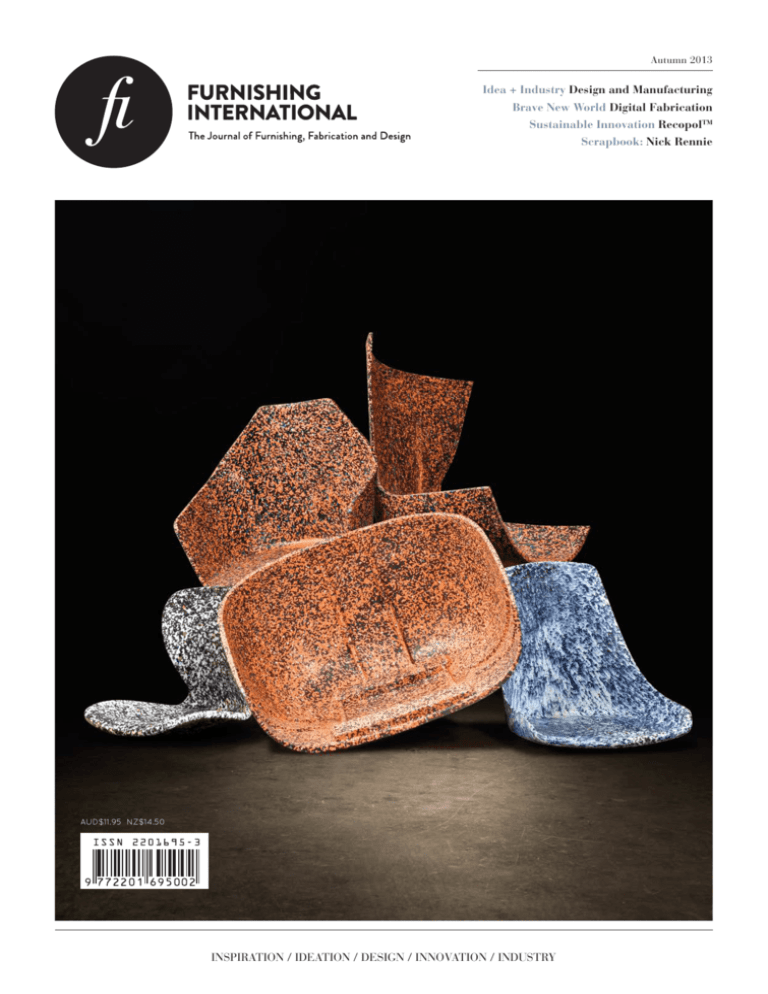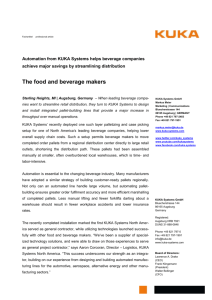Brave New World - Furnishing International
advertisement

Autumn 2013 Idea + Industry Design and Manufacturing Brave New World Digital Fabrication Sustainable Innovation RecopolTM Scrapbook: Nick Rennie AUD$11.95 NZ$14.50 INSPIRATION / IDEATION / DESIGN / INNOVATION / INDUSTRY 048 Capacity: advanced technologies Capacity: advanced technologies 049 I t wasn’t that long ago when 3D printing was purely the domain of comically irrelevant geeky television characters printing their own heads onto Pez dispensers. These days, the gathering momentum and advancements in technology are propelling digital additive manufacturing headlong into the mainstream at superfast broadband speeds. Already this year, we’ve seen 3D printing’s pervasive influence in the worlds of fashion and sports wear, jewellery, furniture, construction and even more unimaginably, Foster and Partners are proposing to build a 3D printed lunar base. But, 3D printing is just one sensation capturing the public’s imagination. In this brave new world of advanced production, ‘robotics’ has replaced ‘green’ as the new buzz word of the decade. RMIT University recently acquired a KUKA robot for the workshop at its School of Architecture and Design. Andrew Thompson, workshop co-ordinator, says, “The University, as part of its more recent strategic plan, saw their strengths in design and technology. So promoting technology within the school of design, was really the nexus of their strategies.” As a designer himself, Andrew saw the opportunity to exploit the digital fabrication side. The robot works through a subtractive process, it carves out of a solid block of material. This is the opposite of 3D printing which is additive, building up layer by layer of material. Operated through software, the robot cuts with millimetre precision. Students at the School of Architecture and Design are able to use the robot make their scale models but the applications for furniture making are enormous. Brave New World Advancements in technological capabilities are set to revolutionise design and manufacturing in the furniture industry. Text Linda Cheng Portrait Ty Layton at Change Creative CapaCity: advanced technologies 050 CapaCity: advanced technologies 051 previous page: Andrew Thompson in RMIT School of Architecture and Design workshop with KUKA robot. Right: Robofold making folded sheet metal interior wall coverings. “ ...if [manufacturers] employed designers and they spent more money on product development then they would most likely realise the full capacity of their machines and the full potential of their business. “ “The thing about these sorts of machines is that you get complexity for free,” says Andrew. “It’s going to take exactly the same amount of time and cost to do something incredibly detailed as it is to do something simple. So you’re going to get arguably more complexity in design which is probably cheaper than hand made furniture.” Andrew is himself a furniture designer and became interested in digital fabrication as a way of negating the limitations of access to distribution. Digital fabrication allows anyone to submit a design and have it robotically manufactured to exact specifications with CAD file, anywhere in the world. “I can sell the designs online and [the customer] can make it in their particular location,” explains Andrew. “So in other words, it’s global design for regional or local manufacturing. Your location in the world as a designer is completely irrelevant, at least in a manufacturing sense.” autumn issue 2013 In a similar vain, Australian manufacturers can take advantage of these technologies to locally manufacture globally sourced design, thereby negating the cost of importing high design from overseas. We’ve seen this democratisation effect happen in many industries due to digitisation. Print on demand, digital printing and e-publications have had a seismic effect on the publishing industry in the last few years. It’s possible that the furniture industry can follow the same road where anyone can design and manufacture anything from anywhere in the world. Our manufacturers need to open their eyes to the possibilities of new technologies. As Andrew says, “The uptake of high technology seems to be really good. But they don’t seem to use it to their full effectiveness. They tend to have really complex and powerful machines, which are only running at a small fraction of their design capacity. So they’re using very powerful machines to do very simple things. They buy these machines because of efficiencies rather than for their ability to create new types of design or new types of products. Those two things actually marry together because if they employed designers and they spent more money on product development then they would most likely realise the full capacity of their machines and the full potential of their business.” Andrew cites three examples (sadly, none Australian) of robotics used in making furnishings. The first is Robofold, a patented six-machine process that sculpts sheet metal into complex shapes that are hard to achieve through conventional methods. The process, usually found in the automotive industry, has so far produced decorative interior wall coverings as well as objects such as bowls. Robofold also offers its method of production as a service to other designers. above left and right: Pongo by Matter Design. 5 axis milled timber coat rack made in three pieces and seemless assembles together to appear as one piece of carved wood. Right: Dirk Vander Kooij’s Endless table being made by 3D printing robot. Pongo designed by Matter Design uses five-axis milling process to carve out the three pieces of wood which assemble into a coat rack. The result is a complex, sculptural design that looks as if it’s been carved from a single piece of wood, which actually would have been almost impossible, not to mention highly expensive. This method of manufacturing allows the three pieces to be “produced efficiently, shipped efficiently and still align with mechanical fasteners”. Lastly, Endless designed by Dirk Vander Kooij combines robotics with 3D printing. The Dutch designer used a decommissioned extruding robotic arm and melted pieces of refrigerator to create the layers of plastic that hardens into a table or chair. Although these robot technologies have been able to create a highly crafted aesthetic with little human interference, it doesn’t mean the end for traditional craftsmanship in furniture making. “In my opinion, what’s going to happen is that you’re going to get a polarisation,” says Andrew. “Fine craft will actually remain and become more valuable and more revered. And you’re also going to get this sort of high end and very complex, digital manufacturing.” What is does mean, however, is a world of new aesthetics and possibilities previous unimaginable through conventional methods of production. As Andrew explains, “It enables us to explore more complex and unique aesthetics that potentially give our furniture manufacturing market and our local furniture designers an edge over other markets that are following design.” KUKa Robotics kuka.com Robofold robofold.com RMit advanced Manufacturing precinct rmit.edu.au/advancedmanufacturing furnishinginternational.com






